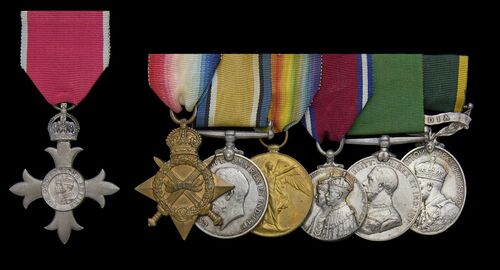
Auction: 24002 - Orders, Decorations and Medals
Lot: 198
(x) The scarce O.B.E. group of seven awarded to Private W. R. Clarke, No. 1 Gun, Bombay Section Volunteer Maxim Gun Company, Indian Defence Force and Bombay Volunteer Rifles who was wounded during the action on the slopes of Latema, German East Africa in March 1916 and later became the Assistant Collector of Customs in Bombay
The Most Excellent Order of the British Empire, O.B.E. (Civil), Officer's 2nd Type breast Badge, silver-gilt; 1914-15 Star (No.128 Pte. W. R. Clarke, Bo. Battn. I.D.F. Attd. Vol. Max. Gun. Coy); British War and Victory Medals (57 Pte. W. R. Clarke, Bo. Vol. Rfls.); Jubilee 1935; Volunteer Force Long Service (India & the Colonies), G.V.R. (Pte. W. R. Clarke, 15-Bom. Bn. I.D.F.); Efficiency Medal, G.VI.R. (Pte. W. R. Clarke, Bombay Bn., A.F.I.), very fine (7)
O.B.E. London Gazette 13 June 1946.
William Robert Clarke served as a Private in the Volunteer Maxim Gun Company (later in the war also known as the Volunteer Machine Gun Company), a unit which served with distinction in East Africa having been drawn from the ranks of the various Indian Volunteer Regiments.
The Indian Volunteer Maxim Gun Company & Latema Hill
In August 1914 the Volunteer units of the Indian Defence Force were recruited from white and mixed-race members of the civilian community whose expectations were that they would only be used operationally within India for local or home defence. However, on the declaration of war, several members of Volunteer units wished to serve overseas, and their willingness allowed the Indian authorities to assemble three units for service in East Africa. An artillery battery, a Maxim Gun Company and a railway defence section were dispatched along with a few specialists such as signallers.
In early 1916, massive numbers of South African reinforcements arrived in theatre and preparations were made for the invasion of German East Africa. The Indian Volunteers now had friendly aircraft flying overhead and armoured cars trundling through the bush besides them. The company was issued with 20 First Line pack mules tended by a Conductor and six 'Cape Boys' from the South African Service Corps. However, two more battles had to be fought on BEA soil and the Company shed blood in both of them.
During the abortive attack on Salaita Hill on 12 February 1916, all six guns of the Company came into action on the South African right flank, but when the assaulting white South African infantry broke and fled under the impact of a ferocious German Askari counterattack, the Indian Volunteers were left in an exposed position. The Company withdrew in good order, but Sergeant J Sinclair (Lucknow) was mortally wounded, dying soon afterwards.
In order to clear a railway route into German East Africa the Latema and Reata hills had to be captured and the new British commander, General Smuts, mounted a set-piece Brigade attack. The Company deployed all six guns in support of the 130th Baluchis who attacked Latema on 11 March. The Germans fiercely contested the hills and the battle ebbed and flowed throughout the afternoon and night until at dawn the enemy commander's nerve failed and he withdrew westwards into German East Africa.
Clarke appears in a group photograph held at the Imperial War Museum, Catalogue number HU 94426.
Subject to 5% tax on Hammer Price in addition to 20% VAT on Buyer’s Premium.
Sold for
£750
Starting price
£320




